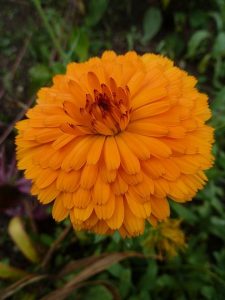Growing Sunshine in Autumn
By Ray Novitske, Fairfax Master Gardener
 If you would like something that blooms well into the fall after the frost sets in, calendula (Calendula officinalis) is a good bet. Calendula is native to the Mediterranean, and its name is derived from the Latin word calends, which means the first day of the month. Also known as a pot marigold, calendula is an annual member of the aster family that is easy to grow and will happily reseed itself year after year so you won’t need to.
If you would like something that blooms well into the fall after the frost sets in, calendula (Calendula officinalis) is a good bet. Calendula is native to the Mediterranean, and its name is derived from the Latin word calends, which means the first day of the month. Also known as a pot marigold, calendula is an annual member of the aster family that is easy to grow and will happily reseed itself year after year so you won’t need to.
This flowering annual blooms with daisy-like 1 to 2 inch yellow or orange blooms that can be single or double. They make great long lasting cut flowers and will attract pollinators to your garden. Its spicy scented leaves are edible and have been used to flavor soups and salads, although the flowers being less bitter are used more often.
The species is an Old World herb and garden plant that was cultivated in England during the time of Shakespeare. It fell out of favor and was considered old fashioned until recently gaining in popularity after the introduction of dwarf and double-flowered cultivars.

Calendula range of colors
Calendula can be planted in a pot with good potting soil or directly in the ground, or started in early spring from seed. It prefers soil that is moderately fertile and well drained, but can also tolerate poor soil, including clay. Its watering needs are not excessive, but it is not drought tolerant.
Calendula likes full sun and part shade. The flowers will bloom throughout the summer, but prefer the cooler weather of spring and autumn. Provide it a little shade during our hot summers and it will be happy. My experience is that it struggles through summer, but will perk up and thrive once the weather begins to cool in September. November is the time it really shines. It tolerates frost while other annuals have been nipped and pulled out for the season.
Young plants can be cut back to encourage compact bushy growth and more blooms. Deadheading spent flowers will promote continuous bloom, but let some produce their seed for the following year. Some sources mention that plants languishing in prolonged hot summer weather can be cut back to promote regrowth later and fall flowering.

Calendula seeds
Besides flavoring foods, calendula has been grown for its medicinal properties, too. It has been used in treatment of skin disorders and pain, and also as a bactericide, antiseptic and anti-inflammatory. The petals and pollen contain triterpenoid esters (an anti-inflammatory). Carotenoids flavoxanthin and auroxanthin are antioxidants and the source of the yellow-orange coloration in the flowers — the same found in carrots and sweet potatoes.
Calendula blooms throughout the season and past the first frost, well into the cold weather. With no serious pests or diseases, it can bring sunshine to your garden as the days get longer and most all else in the garden is gone.
References
Calendula, Cornell University
Growing & Using Calendula, University of California Master Gardeners of San Mateo & San Francisco
Calendula officinalis, Missouri Botanical Garden
Calendula, Arizona State University
…updated 2023